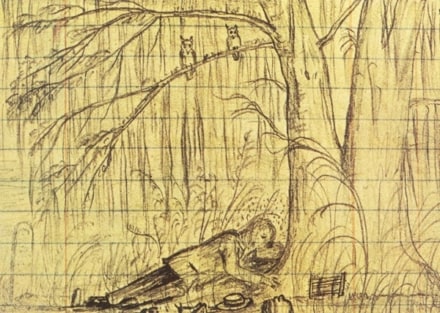
Sermons
Saints in Light
November 1, 2020
All Saints’ Day/ 1st November 2020
On September 2, 1867, John Muir (1838-1914), the Scottish-American writer, natural philosopher, founder of the Sierra Club, left Louisville, Kentucky, crossed the Ohio River, and started walking through the war-ravaged South, heading for Florida, one thousand miles away. His trek took him through Savannah, Georgia, where he arrived with only $3 in his pocket and couldn’t afford lodging. Waiting for money to be wired to him, Muir had no choice but to sleep in St. Bonaventure Cemetery, just south of town.
He spent five nights camped out among the gravestones, under live oak trees draped with moss. He looked at everything around him, noticed every plant, listened to every sound. He saw the way the vines and trees grew over the old gravestones. Steeped in the New Testament, he turned to the language of rebirth, of new eyes, to describe the life-changing insights that came to him, an experience that changed him and shaped the rest of his life. Looking out at the cemetery, he said, “I gazed in this peerless avenue of inverted forest awestruck as one new born, newly arrived from another world without past or future, alive only to the presence of the most adorned and most loving of all the tree companies I have ever beheld.” It gradually dawned on him that the graveyard was alive! He was surrounded by life! “This Bonaventure,” Muir wrote, is “one of the Lord’s elect, [God’s] most favored abodes of clearest light of life.” He wrote in his journal, “The whole place seems like a center of life.”
It was profound experience for Muir. Surrounded by death and decay, he encountered the greater power of life. Death is weak, stingless in the presence of life; it’s powerless before the presence of resurrection and rebirth, which is the power of God’s life. Surrounded by death, he came to know the harmonizing power of life—or, better, Life (with a capital “L”). With new eyes, Muir wrote, later in life, “One can only see by loving; love makes things visible and all labor light. Nobody can be ambitious to do anything wonderful, when God’s wonders are in sight. Every day we should all pray, ‘O Lord, open Thou mine eyes.’” With resurrected eyes, with the eyes of love, all is seen and known.[1]
Long ago, John of Patmos had a similar vision or revelation, not in a graveyard, but in a cave while in exile on an island. He was given a glimpse of the future. He saw a procession of countless multitudes, from all tribes and peoples and languages, standing before the throne and before the Lamb, robed in white, people who have overcome pain and persecution. Angels and elders and the company of heaven stood around the throne and fell on their faces before the throne and worshipped God (Rev. 7:9-17). The Lamb, the Risen Christ, was at the center, the bright Morning Star (Rev. 22:16) that shines forever. There, “they need no light of lamp or sun, for the Lord God will be their light, ….” (Rev. 22:5). The great communion of saints, this glad procession is drawn into doxology, that is, into endless praise of Christ, the Light. What a vision.
And, to be honest, I need to be reminded of this vision. Especially today. And my guess is you do too. Surrounded by so much sadness and loss and death and accumulated grief these days, this All Saints’ Day is poignant, tender, and raw. The U.S. reported 99,321 new COVID-19 cases on Friday—the highest single day number of cases recorded for any country. It’s been a painful year for our nation. We continue to grieve for the family of George Floyd and Breonna Taylor. Many tears are flowing throughout this land today. We too have cried much. This congregation has certainly carried the weight of sorrow and during Communion we’ll invoke the names of those we lost this past year. Death might have lost its sting, but it still hurts and breaks us.
On this All Saints Day in the midst of so much pain and loss, we are bold to claim this truth: that life and death are held by Christ, who sits as “the center” of the throne, the Alpha and Omega, our beginning and our end (Rev. 21:6). The Lamb at the center, the Risen Christ, is our shepherd. The Lamb is the shepherd who even now guides us “to springs of living water” (Rev. 7:17), to the water of life, to that place of safety and assurance and new life, the place where God wipes away every tear—every tear—from our eyes (Rev. 7:17). That is a beautiful image worthy of our contemplation. It’s an image we can return to and imagine and rest in during this time of loss.
For in Christ, “In him all things hold together” (Col. 1:17), heaven and earth are reconciled; past, present, future are one and held together. In Christ, we always stand in some relation to those who’ve gone before us and who now wait for us. We “share,” right now, “in the inheritance of the saints in the light” (Col. 1:12). “We are surrounded,” right now, “by so great a cloud of witnesses” (Hebrews 12:1).
Can you see them? Can you hear them? Can you feel their presence?
The old hymn says it best:
O blest communion, fellowship divine.
We feebly struggle, they in glory shine;
Yet, all are one in thee for all are thine.
Alleluia! Alleluia![2]

Muir’s self-portrait sleeping in St. Bonaventure Cemetery, Savannah.
=================================================================================
[1] B. Hunt, Restless Fires: Young John Muir’s Thousand-Mile Walk to the Gulf in 1867-68 (Macon: Mercer University Press, 2012), p 49. The remaining quotations related to Muir may be found at 49-52, 105-109.
[2] From the hymn “For All the Saints.” Text written by William Walsham How (1823-1897).